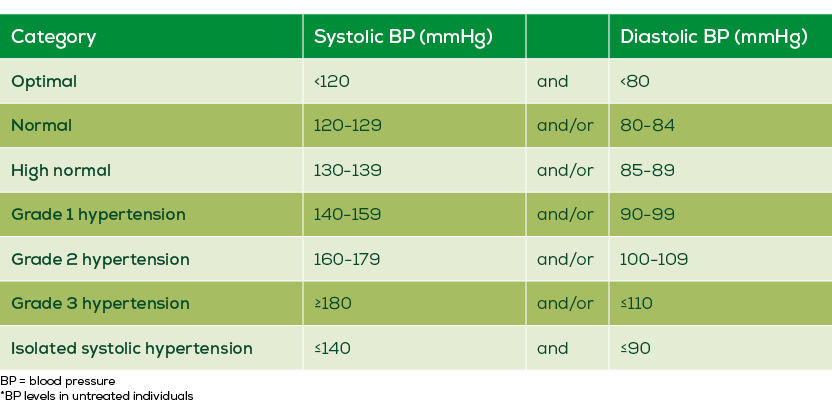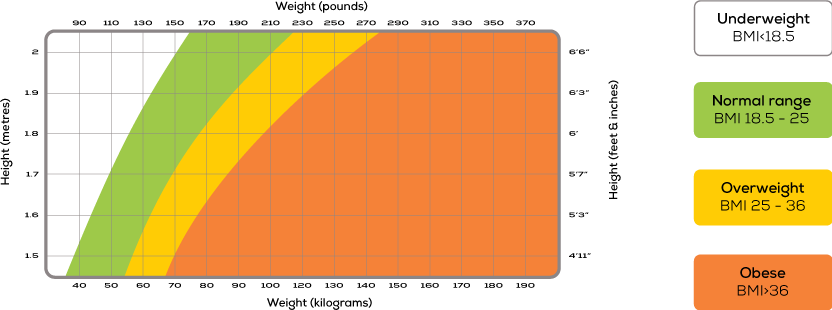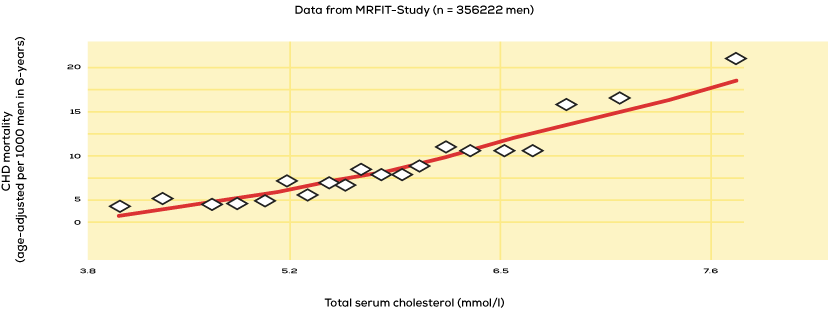1. Raised blood pressure
It has been shown that death from both CHD and stroke increase as blood pressure increases.19
When systolic blood pressure is equal to or above 140 mm Hg and/or a diastolic blood pressure equal to or above 90 mm Hg the blood pressure is considered to be raised or high (see table below). 22

If your patient has raised blood pressure, you will be aware that they are increasing their risk of ischemic heart disease and stroke.23
Modest reductions in blood pressure can significantly lower the risk of CVD. Diet and lifestyle can often have a positive effect on blood pressure.
2. Overweight / obesity
There is a strong relationship between weight and risk of diseases such as type 2 diabetes and CVD. As well as being an independent risk factor, obesity is also a major risk factor for high blood pressure, raised blood cholesterol, diabetes and impaired glucose tolerance.19
Obesity is estimated to affect around one in every four adults and around one in every five children aged 10 to 11 in the UK.24
It’s possible to get an idea of the healthy weight range for your patient through the Body Mass Index (BMI). BMI is calculated by dividing the weight in kilograms by the square of the height in metres, or by plotting height and weight on the BMI chart.25

As BMI increases, so does the risk of heart disease and stroke.8 The BMI ranges only apply to ‘normal’ healthy adults; they’re not appropriate for pregnant women, people with certain medical conditions or children.
Even small reductions in weight can make a positive difference to your patients’ heart health.
3. Diabetes
There are 3.9 million people living with diabetes in the UK.26 Type 2 diabetes is much more common than type 1 diabetes, in the UK, about 90% of all adults with diabetes have type 2.27
Diabetic patients are at an increased risk of CVD. People with type 2 diabetes tend to have lower levels of HDL-cholesterol and raised levels of triglycerides and LDL-cholesterol.28
People with type 2 diabetes can reduce their risk of heart disease by managing their modifiable risk factors.8
4. Elevated cholesterol
Elevated cholesterol is widely accepted as a key modifiable risk factor for CHD, the main form of CVD. More than half of the adult population in Europe have total cholesterol levels that are higher than advisable.29
Total cholesterol consists of LDL-cholesterol (the ‘bad’ cholesterol), HDL-cholesterol and VLDL-cholesterol.
Elevated cholesterol is causally linked to atherosclerosis and CHD risk (see figure below).30,31 Lowering particularly LDL-cholesterol by medication or by adopting a healthy diet and lifestyle can lower the risk of CHD. Evidence for this is based on various types of evidence i.e. observational studies, randomized trials and genetic data.

Cholesterol-lowering drugs (e.g. statins) that have been shown to effectively lower LDL-cholesterol are often prescribed when LDL-cholesterol concentrations are elevated. Also, diet and lifestyle play an important role in lowering LDL-cholesterol , and simple measures can be taken.
*this is not the case for all statins (i.e. ezetimibe), please advise your patient on a case-to-case basis.
